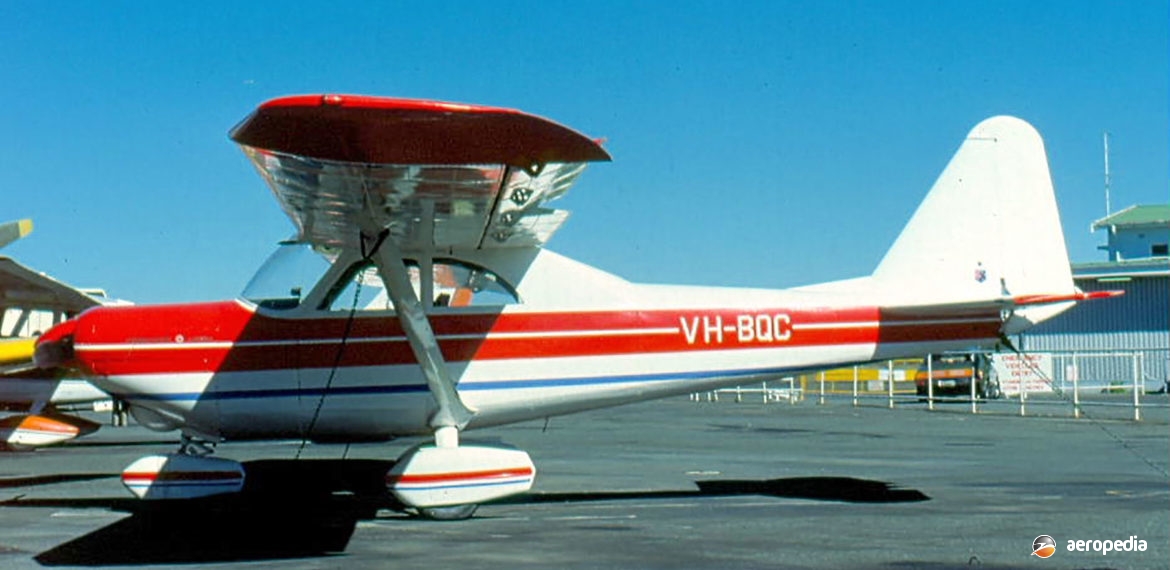Photograph:
Fawcett 120 VH-BQC (c/n 1) at Bankstown, NSW in 1992 (David C Eyre)
Country of origin:
Australia
Description:
Four-seat high-wing light cabin monoplane
Power Plant:
One 97 kw (130 hp) de Havilland Gipsy Major 1 Series 1 four-cylinder in-line air-cooled engine
Specifications:
- Wingspan: 10.87 m (35 ft 8 in)
- Length: 6.91 m (22 ft 8 in)
- Height: 2.06 m (6 ft 9 in)
- Wing area: 17.2 m² (185 sq ft)
- Max speed: 204 km/h (127 mph)
- Cruising speed: 172 km/h (107 mph)
- Initial rate of climb at sea level: 183 m/min (600 ft/min)
- Service ceiling: 4,450 m (14,600 ft)
- Range: 805 km (500 miles)
- Empty weight: 502 kg (1,107 lb)
- Loaded weight: 907 kg (2,000 lb)
History:
The Fawcett 120 was a high-wing all-metal monoplane designed by Luigi Pellarini in 1953 and built by Fawcett Aviation Pty Ltd of Bankstown, NSW. It was designed as a replacement for the de Havilland DH.82A Tiger Moth trainer then in use by a subsidiary of Fawcett, the Illawarra Flying School. Mr Pellarini was well known in this region for his aircraft designs, having also been involved in the design and construction of the Kingsford Smith PL-7 Tanker, the Bennett Airtruck (New Zealand), the Victa R-2 and the Transavia Airtruk.
Construction of the prototype Fawcett 120 began in February 1953, and it was flown for the first time on 11 November 1954. Allotted the registration VH-BQC (c/n 1), it was equipped with a tricycle undercarriage and was initially powered by a de Havilland Gipsy Major engine with a wooden fixed-pitch propeller. Full dual controls were fitted.
Following type-approval tests at the Aircraft Research and Development Unit (ARDU) at the RAAF base at Laverton, VIC the prototype was evaluated by the Australian Army, and comparison tests made with an Auster AOP III, but eventually the decision was made to obtain the imported Cessna 180 for that service.
The proposed production aircraft was to differ in a number of ways from the prototype. The cabin was to be larger with increased head and leg-room in both the front and rear seats. It was to have a re-designed fin, rudder, tailplane and elevators, an increase in the all-up weight to 1,066 kg (2,350 lb), and increased fuel capacity. Also, hydraulically-operated brakes instead of the mechanically-operated units, and control wheels, were to be fitted.
Pilots reported that the prototype was very stable and, when trimmed properly, could be flown ‘hands and feet off’ indefinitely, and was aerobatic. After 113 hours of test and development flying the aircraft was mothballed and the project abandoned as sufficient orders were not forthcoming.
The aircraft was then stored for about 20 years at Bankstown, NSW in the Fawcett hangar until the late 1970s, when it was rebuilt. During 1979, it re-appeared with an American Lycoming four-cylinder, horizontally-opposed engine in a new white with red trim colour scheme (in place of the previous natural metal with green trim).
Little flying was done but during 1986 the engine was removed and it was again stored in the Fawcett hangar. In 1990 it was again re-assembled, changes having been made to regulations which meant the type could be placed on the Australian Civil Aircraft Register. It was re-engined with a 134 kw (180 hp) Lycoming O-360 engine and fitted with a Hartzell constant-speed propeller. A number of test flights were carried out, the first on 8 August 1990.
In 1999 the Fawcett was donated by Douglas Richard Fawcett to and placed on display at the Australian Aviation Museum at Bankstown but following the closure of the museum in 2018 and subsequently by the Benalla Avition Museum in Victoria where it has been placed on display.

